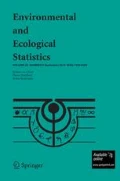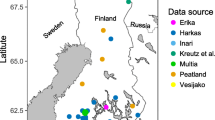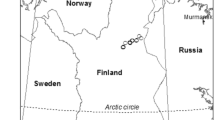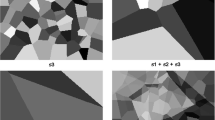Abstract
Adaptive cluster sampling (ACS) has the potential of being superior for sampling rare and geographically clustered populations. However, setting up an efficient ACS design is challenging. In this study, two adaptive plot designs are proposed as alternatives: one for fixed-area plot sampling and the other for relascope sampling (also known as variable radius plot sampling). Neither includes a neighborhood search which makes them much easier to execute. They do, however, include a conditional plot expansion: at a sample point where a predefined condition is satisfied, sampling is extended to a predefined larger cluster-plot or a larger relascope plot. Design-unbiased estimators of population total and its variance are derived for each proposed design, and they are applied to ten artificial and one real tree position maps to estimate density (number of trees per ha) and basal area (the cross-sectional area of a tree stem at breast height) per hectare. The performances—in terms of relative standard error (SE%)—of the proposed designs and their non-adaptive alternatives are compared. The adaptive plot designs were superior for the clustered populations in all cases of equal sample sizes and in some cases of equal area of sample plots. However, the improvement depends on: (1) the plot size factor; (2) the critical value (the minimum number of trees triggering an expansion); (3) the subplot distance for the adapted cluster-plots, and (4) the spatial arrangement of the sampled population. For some spatial arrangements, the improvement is relatively small. The adaptive designs may be particularly attractive for sampling in rare and compactly clustered populations with critical value of 1, subplot distance equal to the diameter of initial circular plots, or plot size factor of 2.5 for an initial basal area factor of 2.












Similar content being viewed by others
References
Acharya B, Bhattarai G, Gier Ad, Stein A (2000) Systematic adaptive cluster sampling for the assessment of rare tree species in Nepal. For Ecol Manage 137:65–73
Bitterlich W (1948) Die Winkelzählprobe. Allgemeine Forst- und Holzwirtschaftliche Zeitung 59:4–5
Brown JA (2003) Designing an efficient adaptive cluster sample. Environ Ecol Stat 10:95–105
Brown JA, Manly BJF (1998) Restricted adaptive cluster sampling. Environ Ecol Stat 5:49–63
Brown JA, Salehi MM, Moradi M, Bell G, Smith DR (2008) An adaptive two-stage sequential design for sampling rare and clustered populations. Popul Ecol 50:239–245
Cao Y, Williams DD, Williams NE (1998) How important are rare species in aquatic community ecology and bioassessment? Limmol Oceanogr 43:1403–1409
Christman MC, Lan F (2001) Inverse adaptive cluster sampling. Biometrics 57:1096–1105
Christman MC, Pontius JS (2000) Bootstrap confidence intervals for adaptive cluster sampling. Biometrics 56:503–510
Dryver AL, Chao C-T (2007) Ratio estimators in adaptive cluster sampling. Environmetrics 18:607–620
Dryver AL, Thompson SK (2005) Improved unbiased estimators in adaptive cluster sampling. J R Stat Soc B 67:157–166
Edwards TC, Cutler DR, Zimmermann NE, Geiser L, Alegria J (2005) Model-based stratifications for enhancing the detection of rare ecological events : The statistics of rarity. Ecological Society of America, Washington
Fehrmann L, Gregoire T, Kleinn C (2012) Triangulation based inclusion probabilities: a design-unbiased sampling approach. Environ Ecol Stat 19:107–123
Félix-Medina MH, Thompson SK (2004) Adaptive cluster double sampling. Biometrika 91:877–891
Ferretti M (2013) Chapter 1—forest monitoring: an introduction. In: Marco F, Richard F (eds) Developments in environmental science. Elsevier, Amsterdam, pp 3–18
FRA (2010) Global forest resources assessment 2010: main report, FAO
Gregoire TG (1982) The unbiasedness of the mirage correction procedure for boundary overlap. Forest Sci 28:504–508
Gregoire TG, Valentine HT (2008) Sampling strategies for natural resources and the environment. Chapman & Hall/CRC, Boca Raton
Grosenbaugh LR (1952) Plotless timber estimates-new, fast, easy. J Forest 50:32–37
Husch B, Miller CI, Beers TW (1982) Forest mensuration. Wiley, New York
Kleinn C, Vilčko F (2006) Design-unbiased estimation for point-to-tree distance sampling. Can J For Res 36:1407–1414
Magnussen S, Werner K, Leckie DG, Paradine D (2005) Adaptive cluster sampling for estimation of deforestation rates. Eur J For Res 124(3): 207–220
Magurran AE, Henderson PA (2003) Explaining the excess of rare species in natural species abundance distributions. Nature 422:714–716
Matérn B (1986) Spatial variation, 2nd edn. Springer, Berlin
Phillipi T (2005) Adaptive cluster sampling for estimation of abundances within local populations of low-abundance plants. Ecology 86:1091–1100
Raphael MG, Molina R (2007) Conservation of rare or little-known species: biological, social, and economic considerations. Island Press, Washington
Roesch FA Jr (1993) Adaptive cluster sampling for forest inventories. For Sci 39:655–669
Roesch FA Jr, Green EJ, Scott CT (1993) An alternative view of forest sampling. Survey Methodol 19:199–204
Salehi MM, Seber GAF (2005) Two-stage sequential sampling: a neighborhood-free adaptive sampling procedure. J Agric Biol Environ Stat 10(1):84–103
Smith DR, Brown JA, LO NCH (2004) Application of adaptive sampling to biological populations. In: Thompson WL (ed) Sampling rare or elusive species:concepts, designs, and techniques for estimating population parameters. Island Press, Covelo, pp 75–122
Smith DR, Villella RF, Lemarié DP (2003) Application of adaptive cluster sampling to low-density populations of freshwater mussels. Environ Ecol Stat 10:7–15
Stevens Jr. DL (2006) Edge effect. In: Encyclopedia of environmetrics. John Wiley & Sons Ltd, New York
Talvitie M, Leino O, Holopainen M (2006) Inventory of sparse forest populations using adaptive cluster sampling. Silva Fennica 40:101–108
Thompson SK (1990) Adaptive cluster sampling. J Am Stat Assoc 85:1050–1059
Thompson SK (1991) Stratified adaptive cluster sampling. Biometrika 78:389–397
Thompson SK (2006) Adaptive web sampling. Biometrics 62:1224–1234
Thompson SK, Seber GAF (1996) Adaptive sampling. Wiley, New York
Thompson SK (2013) Adaptive web sampling in ecology. Stat Methods Appl 22:33–43
Tout J (2009) An analysis of the adaptive cluster sampling design with rare plant point distributions. Humboldt State University
Yang H (2011) New adaptive plot designs for sampling rare and clustered populations. George-August-Universtiy Goettingen
Yang H, Kleinn C, Fehrmann L, Tang S, Magnussen S (2011) A new design for sampling with adaptive sample plots. Environ Ecol Stat 18:223–237
Acknowledgments
First of all, we would like to gratefully acknowledge the financial support of DFG (German Research Foundation) for the research project KL 894/10-1. The results presented in this paper are part of that project. Our sincere thanks go to Prof. Dr. Shouzheng Tang, Prof. Dr. Yuancai Lei and Dr. Guangyu Zhu for their kind support during the field work of mapping our real population. Finally, we are grateful to the anonymous reviewers for a very careful and thorough reviewing of this manuscript with valuable comments and suggestions that prompted a number of improvements.
Author information
Authors and Affiliations
Corresponding author
Ethics declarations
Conflict of interest
We hereby declare that we have no conflict of interest.
Additional information
Handling Editor: Bryan F. J. Manly.
Rights and permissions
About this article
Cite this article
Yang, H., Magnussen, S., Fehrmann, L. et al. Two neighborhood-free plot designs for adaptive sampling of forests. Environ Ecol Stat 23, 279–299 (2016). https://doi.org/10.1007/s10651-015-0339-2
Received:
Revised:
Published:
Issue Date:
DOI: https://doi.org/10.1007/s10651-015-0339-2




